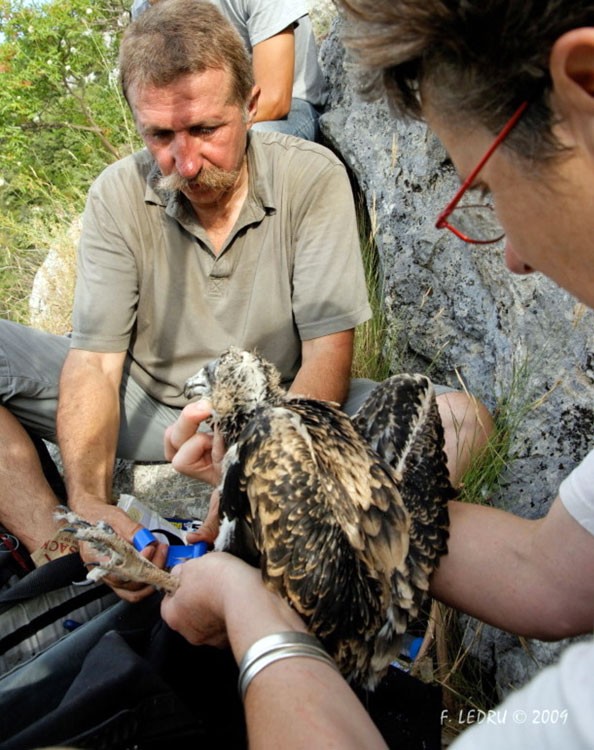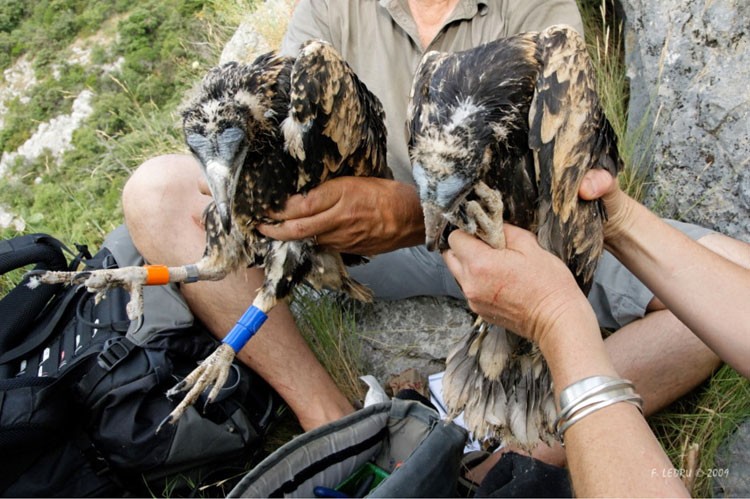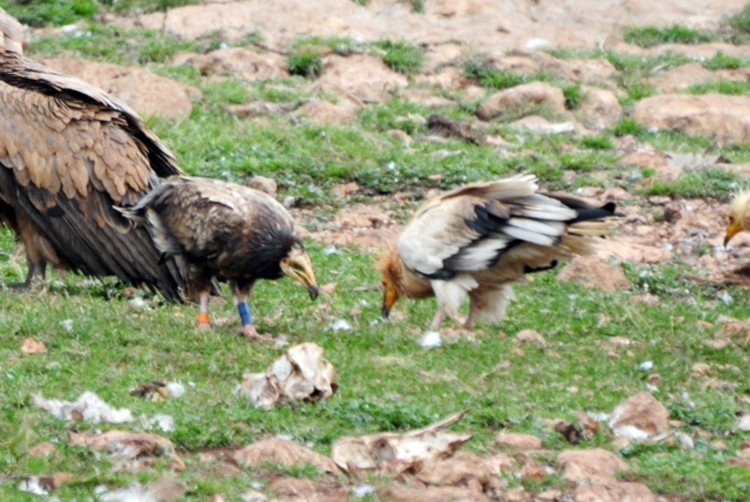… return visits are promising for the species.
As France’s 2011 Egyptian vulture population is being ringed, here is a summary of recent insights into the lives of Egyptian vultures in the Hérault department, encouraging us, the many people who help to support the species in this area, in our work.
It also provides an opportunity to mention that a completely new species – the cinereous vulture – is nesting in the Hérault department, 23 km away from the reproduction site of the department’s Egyptian vultures (the only site at present). Cinereous vultures are a new nesting species, with the adults occasionally observed at the main feeding area for Egyptian vultures in the Hérault department.
During a trip around Catalonia in which I continued to observe and learn more about vultures – a never-ending and borderless educational experience – I spoke to Marc Galvez, who is in charge of tracking Boumort’s cinereous vultures. While observing over 250 griffon vultures at a feeding area, where there were also 8 Egyptian vultures, 12 cinereous vultures, with at least 1 from the Cévennes, and 6 bearded vultures, he spoke to me about and, best of all, showed me a picture on his iPod of an immature Egyptian vulture with coloured rings… ‘Orange with a D on, blue-blue with a G on’… that had been spotted locally in Boumort (Spain) three times in the previous week.
It was time to go back (over 450 km…) and get out the 2009 photographs that I could already picture in my mind… but nothing beats actual confirmation – and here was some good news!
 Of the 2 young birds ringed in 2009 (with Max Gallardo (from PNR du Luberon [the Luberon Regional Nature Park], in charge of ringing in the south-east) and Alain Ravayrol (from Association La Salsepareille) on the cliff in the Thaurac site in the Hérault department), one was photographed in Gibraltar (Spain) on 21st September 2009, some 3 weeks after both were observed leaving the site of their birth on 26.08.09 and just before crossing the southern Mediterranean, a few minutes after two adults and another juvenile bird (seen by J Wright from Migres) with the other, its younger brother, or sister, photographed on 15th June last year in Boumort, Catalonia (Spain) – a full 2 years later, alongside the 4 species of vulture at the site.
Of the 2 young birds ringed in 2009 (with Max Gallardo (from PNR du Luberon [the Luberon Regional Nature Park], in charge of ringing in the south-east) and Alain Ravayrol (from Association La Salsepareille) on the cliff in the Thaurac site in the Hérault department), one was photographed in Gibraltar (Spain) on 21st September 2009, some 3 weeks after both were observed leaving the site of their birth on 26.08.09 and just before crossing the southern Mediterranean, a few minutes after two adults and another juvenile bird (seen by J Wright from Migres) with the other, its younger brother, or sister, photographed on 15th June last year in Boumort, Catalonia (Spain) – a full 2 years later, alongside the 4 species of vulture at the site.
 The tale of the two siblings from the Thaurac, 2009 group is a good one, that primarily came about through a great deal of luck and also as a result of using the latest coloured rings, without which the journey to Africa would not have been observed, and especially because of bird watchers seeing ‘our’ birds at the right time that year, even without – as is the case at present – GPS.
The tale of the two siblings from the Thaurac, 2009 group is a good one, that primarily came about through a great deal of luck and also as a result of using the latest coloured rings, without which the journey to Africa would not have been observed, and especially because of bird watchers seeing ‘our’ birds at the right time that year, even without – as is the case at present – GPS.
 A lot of questions arose at the same as this good news: Would the immature birds not spend as many years in Africa as had been detailed until then?
A lot of questions arose at the same as this good news: Would the immature birds not spend as many years in Africa as had been detailed until then?
The Egyptian vulture tracking that has been carried out in Spain in recent years seems to show a large number of non-reproductive Egyptian vultures (immature and adult birds) in feeding areas and at roosting sites in Navarre, the Basque Country and Catalonia (and also in France, since we have a ‘roost’ with perches). These are individual birds that leave for the Sahel in winter, except for a very small remaining group that winters in Doñana. There is still a lot of data to process about this species – one that is truly borderless.
Long live Buitreros et Alimocheros Sin Fronteras – Egyptian vultures without borders.
Association Goupil Connexion
Tracking and conservation of Egyptian vultures in the Hérault department
34190 Brissac
www.cpn2007.org

No responses yet